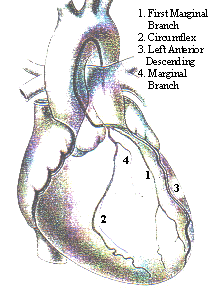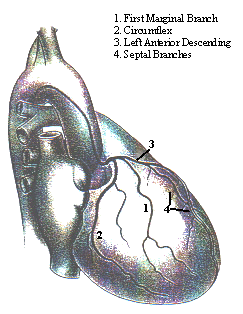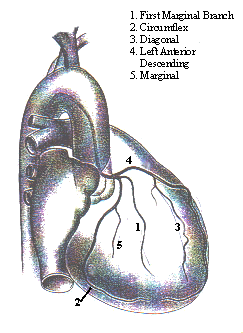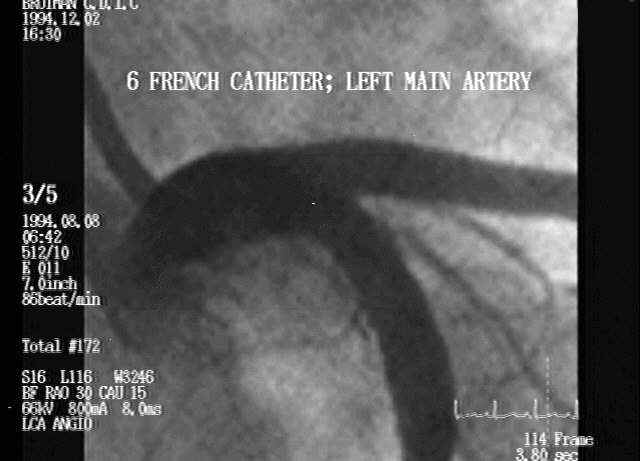Medical Pharmacology Chapter 43: Adult Cardiac Procedures
|
|
|
Medical Pharmacology Chapter 43: Adult Cardiac Procedures
|
|
|
Cardiac Catherization
|
|
|
 |
 |
 |
 |
|
|
|
|
|
|
|
Extent of coronary vessel disease (stenoses)
Worst-case:"triple vessel disease" -- definition of extent of vessel involvement
Left anterior descending artery
Left circumflex artery
Right coronary artery
Definition: "complete occlusion with collateral filling" = normal blood supply lost; however, some perfusion remains through collateral vessels from neighboring arteries
Most serious condition: "left main" coronary stenosis:
Reason: left main coronary (which bifurcates into left anterior descending and left circumflex components) supplies most of the left ventricle
Occlusion of left main coronary vessels would cause significant ventricular dysfunction, secondary to ischemia (note that the right coronary arteries supplies some collateral flow to regions of the anterior descending and circumflex vessel)
Under some circumstances the left main artery may be open, but occlusion might exist in branches, such as circumflex and left anterior descending and right coronary:
This condition can be described as "left main equivalent", meaning that although the left main artery is normal, significant ischemia may occur with further coronary blood flow reduction
Very advanced coronary artery disease may be present in the absence of abnormal indices of ventricular performance
Angina on exertion may exist -- with no history of myocardial infarction
Poor ventricular performance may be consistent with:
Previous myocardial infarction
Ongoing myocardial infarction
|
|
|
Right vs. Left coronary Artery Dominance:
Right dominance: Frequency = 85%; right coronary artery continues onto the posterior cardiac wall as a posterior descending vessel
Posterior descending coronary supplies:
Posterior and
Diaphragmatic part of the interventricular septum
Arteriovenous (AV) nodal artery is right from the right coronary artery
Left dominance: Frequency = 8% circumflex coronary artery traverses inferiorly down the back of the heart (major posterior descending coronary artery) (remaining 7%, indeterminate by angiographic analysis)
Relevance to the anesthesia provider:
Right-dominant patient: Air bubbles from the aorta most often enter the right coronary artery (right coronary arises from "anterior" [i.e. uppermost part in the supine intraoperative room patient position] in a right-dominant system, air can enter the AV nodal artery, producing heart block.
Left-dominant patient with left circumflex and/or left main vessel disease may experience:
Poor protection my cardioplegia
Marginal perfusion of the left ventricular posterior wall
Difficulty in separation from bypass perfusion system
Coronary angiographic standards and limitations in assessment of the degree of stenosis:
Gold Standard
Limited use in predicting physiological significance of lesions
Difficulty in assessing lesion asymmetry with single radiographic projection
Significant interobserver variability
Primary Reference: Ross, AF, Gomez, MN. and Tinker, JH Anesthesia for Adult Cardiac Procedures in Principles and Practice of Anesthesiology (Longnecker, D.E., Tinker, J.H. Morgan, Jr., G. E., eds) Mosby, St. Louis, Mo., pp. 1659-1698, 1998.
Primary Reference: Shanewise, JS and Hug, Jr., CC, Anesthesia for Adult Cardiac Surgery, in Anesthesia, 5th edition,vol 2, (Miller, R.D, editor; consulting editors, Cucchiara, RF, Miller, Jr.,ED, Reves, JG, Roizen, MF and Savarese, JJ) Churchill Livingston, a Division of Harcourt Brace and Company, Philadelphia, pp. 1753-1799, 2000.
Primary Reference: Wray Roth, DL, Rothstein, P and Thomas, SJ Anesthesia for Cardiac Surgery, in Clinical Anesthesia, third edition (Barash, PG, Cullen, BF, Stoelting, R.K, eds), Lippincott-Raven Publishers, Philadelphia, pp. 835-865, 1997
4Zanger, D.R, Solomon, A.J., Gersh, BJ, Contemporary Management of Angina: Part I. Risk Assessment American Family Physician, December 1, 1999
5Kay, GL, Sun, GW, Aoki, A, et al: Influence of ejection fraction on hospital mortality, morbidity, and costs for CABG patients, Ann. Thorac Surg 60 (6): 1640-1650, 1995 (2nd sourced from Ross, AF, Gomez, MN. and Tinker, JH Anesthesia for Adult Cardiac Procedures in Principles and Practice of Anesthesiology (Longnecker, D.E., Tinker, J.H. Morgan, Jr., G. E., eds) Mosby, St. Louis, Mo., pp. 201-218, 1998)
|
This Web-based pharmacology and disease-based integrated teaching site is based on reference materials, that are believed reliable and consistent with standards accepted at the time of development. Possibility of human error and on-going research and development in medical sciences do not allow assurance that the information contained herein is in every respect accurate or complete. Users should confirm the information contained herein with other sources. This site should only be considered as a teaching aid for undergraduate and graduate biomedical education and is intended only as a teaching site. Information contained here should not be used for patient management and should not be used as a substitute for consultation with practicing medical professionals. Users of this website should check the product information sheet included in the package of any drug they plan to administer to be certain that the information contained in this site is accurate and that changes have not been made in the recommended dose or in the contraindications for administration. Advertisements that appear on this site are not reviewed for content accuracy and it is the responsibility of users of this website to make individual assessments concerning this information. Medical or other information thus obtained should not be used as a substitute for consultation with practicing medical or scientific or other professionals. |